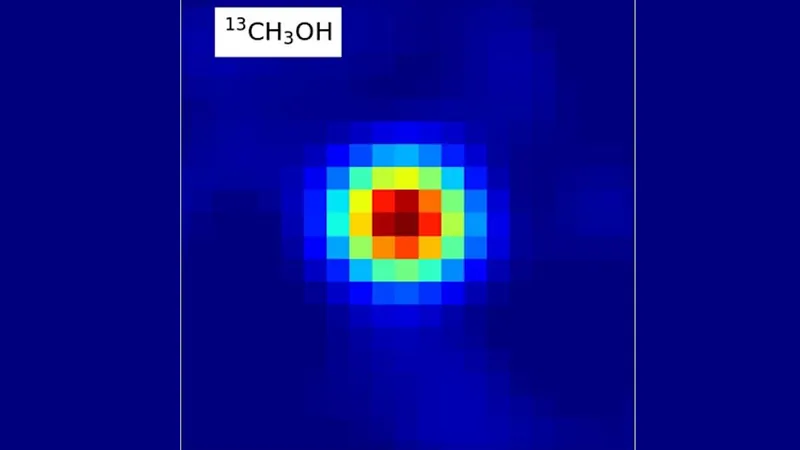
B335: The Cosmic Lab Unraveling the Secrets of Star Formation and Chemistry
2024-12-29
Author: Yu
Introduction
In a groundbreaking discovery, scientists have made significant strides in understanding the chemical processes that occur during the formation of new stars, focusing on the enigmatic protostar B335, located 537 light years away. This variable protostar has piqued the interest of researchers eager to learn more about astrochemistry—the study of the chemical processes and molecules in space that could ultimately give rise to life.
Observations with ALMA
Utilizing the advanced capabilities of the Atacama Large Millimeter/submillimeter Array (ALMA) in Chile, researchers conducted real-time observations of B335 as it underwent a rare and dramatic increase in brightness. This provided a unique opportunity to track complex organic molecules (COMs) and investigate their transformation during this explosive phase.
Episodic Growth of Stars
Stars like B335 don’t just form steadily; they experience episodic growth, often punctuated by sudden bursts when large masses of material fall onto them. These events increase the star's luminosity, heating surrounding dust and causing previously frozen COMs to be released into the surrounding gas. However, the team was startled to find that after the brightness spike subsided, the COMs did not refreeze onto the dust as quickly as initially anticipated.
Implications of the Findings
Lead researcher Jeong-Eun Lee from Seoul National University emphasizes the significance of this finding, saying, 'This discovery challenges previous assumptions about the freeze-out timescale of these molecules. The extended presence of gas-phase COMs highlights the dynamic and intricate chemical processes occurring around young stars.'
Real-Time Tracking of Molecular Changes
The study represents the first instance of real-time tracking of molecular changes throughout a star’s brightness cycle, thanks to ALMA’s exceptional sensitivity. Continued observations of B335 will provide critical insights into the timescales for gas cooling, chemical reactions, and the interplay between dust grains and gaseous molecules.
B335 as a Natural Laboratory
In a fascinating twist, B335 serves as a 'natural laboratory' for astrochemistry, allowing scientists to observe processes that would be impossible to replicate in terrestrial laboratories. This unprecedented opportunity could shed light on how the fundamental ingredients for life evolve in stellar nurseries.
Combining Data from ALMA and JWST
Moreover, by synthesizing ALMA’s findings with data from the James Webb Space Telescope (JWST) concerning the icy components of COMs within B335, the team hopes to map out the complete chemistry of these crucial molecules. Co-author Yao-Lun Yang from RIKEN stated, 'By combining the ALMA results with JWST data, we will unlock the full chemistry of COMs, enhancing our understanding of the building blocks of life.'
Conclusion
The study, published in the prestigious Astrophysical Journal Letters under the title “A Natural Laboratory for Astrochemistry, a Variable Protostar B335,” marks an exciting new chapter in the exploration of cosmic chemistry and the formation of life-sustaining molecules throughout the universe. Stay tuned as researchers continue to monitor this fascinating protostar, which may hold answers to some of the most profound questions about the origin of life in our universe. The ongoing exploration of cosmic laboratories like B335 could lead to revelations that change how we view our place in the cosmos.
 Brasil (PT)
Brasil (PT)
 Canada (EN)
Canada (EN)
 Chile (ES)
Chile (ES)
 Česko (CS)
Česko (CS)
 대한민국 (KO)
대한민국 (KO)
 España (ES)
España (ES)
 France (FR)
France (FR)
 Hong Kong (EN)
Hong Kong (EN)
 Italia (IT)
Italia (IT)
 日本 (JA)
日本 (JA)
 Magyarország (HU)
Magyarország (HU)
 Norge (NO)
Norge (NO)
 Polska (PL)
Polska (PL)
 Schweiz (DE)
Schweiz (DE)
 Singapore (EN)
Singapore (EN)
 Sverige (SV)
Sverige (SV)
 Suomi (FI)
Suomi (FI)
 Türkiye (TR)
Türkiye (TR)
 الإمارات العربية المتحدة (AR)
الإمارات العربية المتحدة (AR)